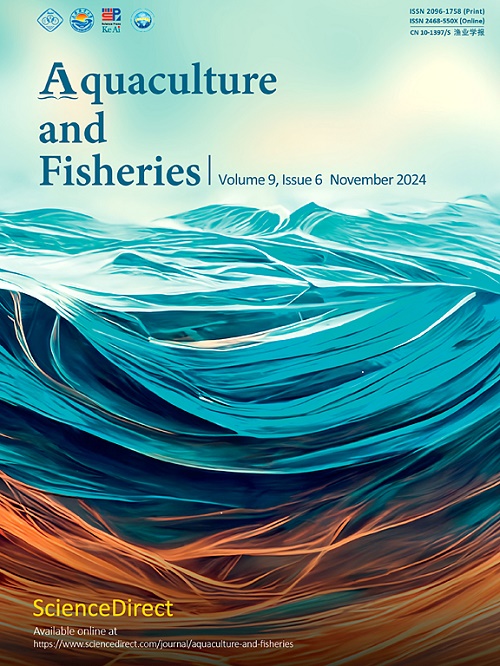尼罗罗非鱼盐度胁迫相关 lncRNA 的全基因组鉴定
Q1 Agricultural and Biological Sciences
引用次数: 0
摘要
长链非编码rna (lncRNAs)越来越被认为是各种生物过程中的关键角色,但它们在鱼类对盐度变化的反应中的作用仍未得到充分研究。本研究对尼罗罗非鱼(Oreochromis niloticus)的lncrna进行了全基因组分析,通过来自9个不同组织的98个RNA-seq样本的大量数据集检查了它们对盐度胁迫的反应。我们确定了28,819个高置信度lncRNA候选物,其特征是与mrna相比,平均长度较短,为788个核苷酸,外显子较少(平均为1.84个)。具体来说,在暴露于盐度27三个半月的鱼鳃中,我们发现了846个差异表达的lncrna (delncrna),包括342个上调转录本和504个下调转录本。该研究还强调了220对重要的DElncRNA-mRNA对,表明了潜在的调控相互作用。值得注意的是,在急性盐度胁迫下,我们在鳃中发现了989个delncrna,其中414个上调,575个下调。对这些delncrna的分析显示了348对高可信度对,基因本体(GO)和KEGG通路分析表明,大多数靶基因(如trim7、trim35、trim47、cd225)在免疫炎症反应中发挥着突出作用。至关重要的是,两个DElncRNAs (ENSONIT00000076723和MSTRG.18195.2)被发现与耐盐性相关的QTL区间共定位,位于三个显著snp附近。此外,由mRNA ENSONIT00000087370 (apold1a)和lncRNA ENSONIT00000076723组成的一个显着的顺式作用对在急性和慢性低渗透应激下显示出很强的相关性。我们的研究结果大大拓宽了lncrna在盐度胁迫适应中的理解,并表明它们在尼罗罗非鱼渗透调节机制中发挥了关键调节作用。本文章由计算机程序翻译,如有差异,请以英文原文为准。
Genome-wide identification of salinity stress-associated lncRNAs in Nile tilapia
Long noncoding RNAs (lncRNAs) are increasingly recognized as key players in various biological processes, yet their role in fish's response to salinity changes remains largely unexplored. This study undertakes a genome-wide analysis of lncRNAs in Nile tilapia (Oreochromis niloticus), examining their response to salinity stress across a substantial dataset of 98 RNA-seq samples from nine different tissues. We identified 28,819 high-confidence lncRNA candidates, which are characterized by a shorter average length of 788 nucleotides and fewer exons (average 1.84) compared to mRNAs. Specifically, in the gills exposed to salinity 27 for three and a half months, we found 846 differentially expressed lncRNAs (DElncRNAs), including 342 upregulated and 504 downregulated transcripts. The study also highlighted 220 significant DElncRNA-mRNA pairs, indicating potential regulatory interactions. Notably, in response to acute salinity stress, we identified 989 DElncRNAs, with 414 upregulated and 575 downregulated in gills. An analysis of these DElncRNAs revealed 348 high-confidence pairs, with Gene Ontology (GO) and KEGG pathway analyses indicating a prominent role in immune-inflammatory responses for most target genes, such as trim7, trim35, trim47, cd225. Crucially, two DElncRNAs (ENSONIT00000076723 and MSTRG.18195.2) were found to co-localize with QTL intervals associated with salinity tolerance, situated near three significant SNPs. Additionally, a notable cis-acting pair, consisting of mRNA ENSONIT00000087370 (apold1a) and lncRNA ENSONIT00000076723, demonstrated a strong correlation under both acute and chronic hypo-osmotic stress. Our findings significantly broaden the understanding of lncRNAs in salinity stress adaptation and suggest their novel roles as key regulators in the osmoregulatory mechanisms of Nile tilapia.
求助全文
通过发布文献求助,成功后即可免费获取论文全文。
去求助
来源期刊

Aquaculture and Fisheries
Agricultural and Biological Sciences-Aquatic Science
CiteScore
7.50
自引率
0.00%
发文量
54
审稿时长
48 days
期刊介绍:
 求助内容:
求助内容: 应助结果提醒方式:
应助结果提醒方式:


